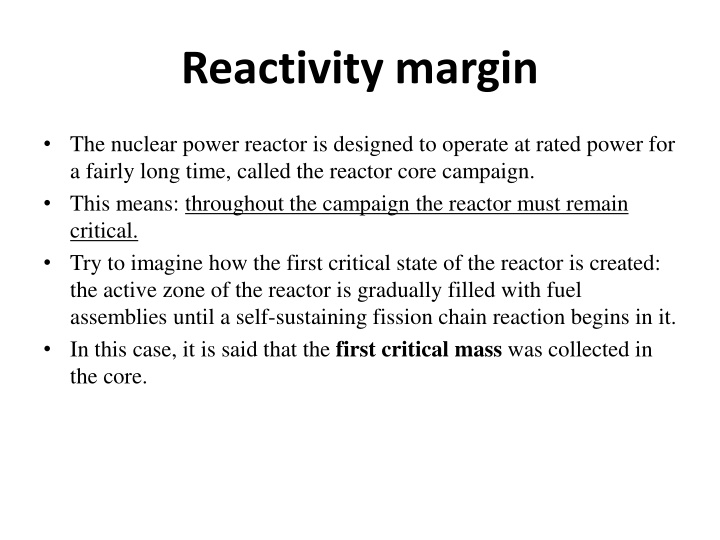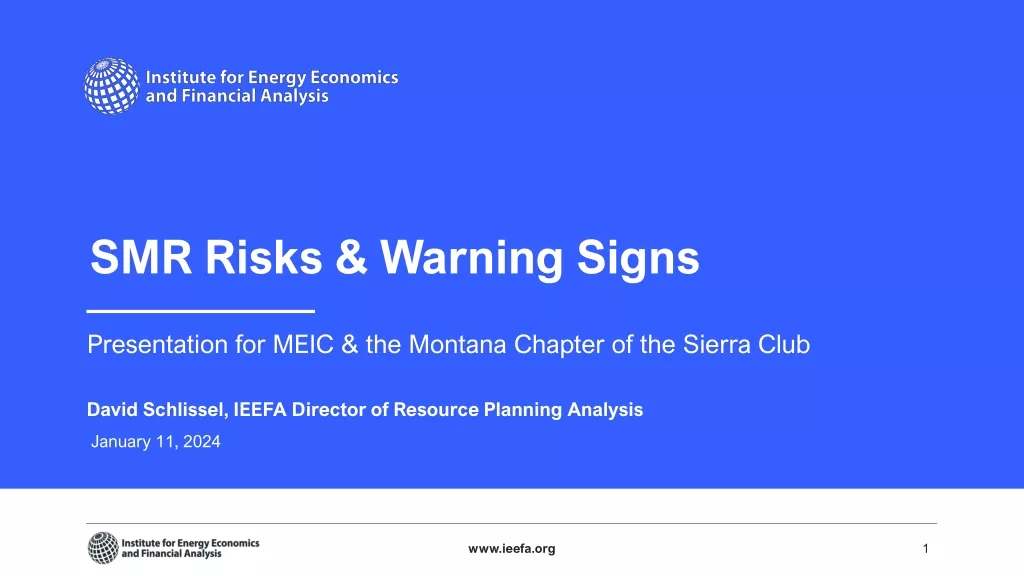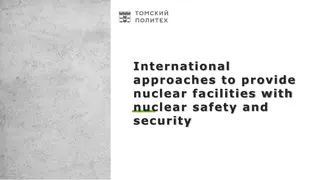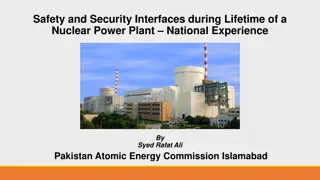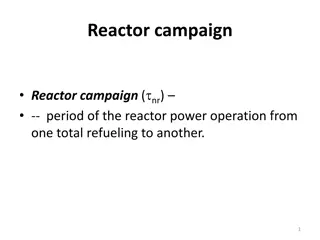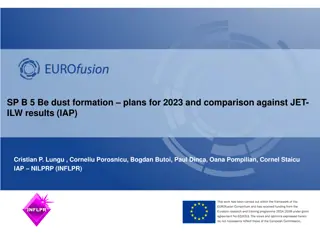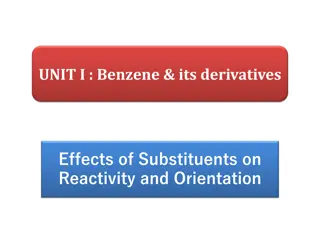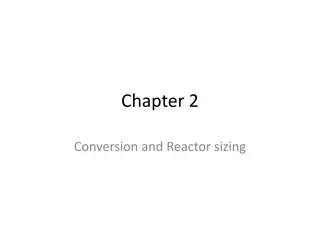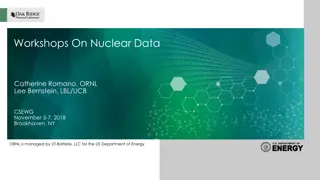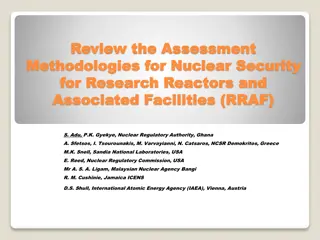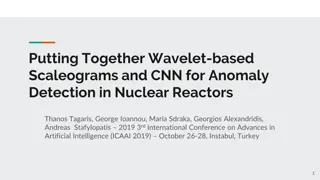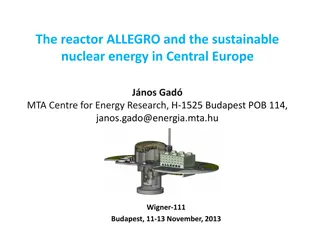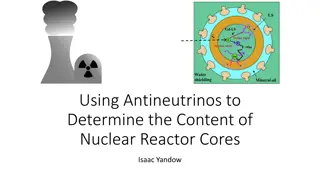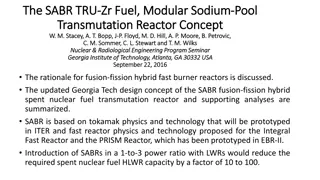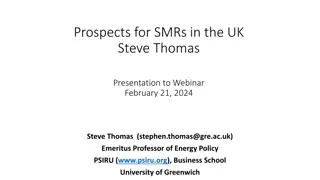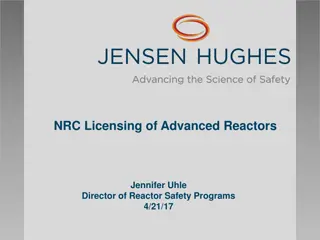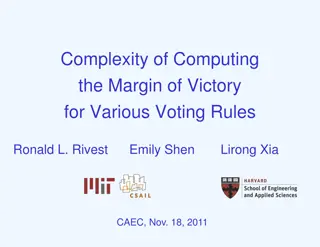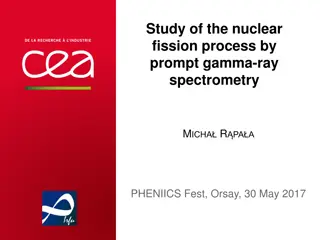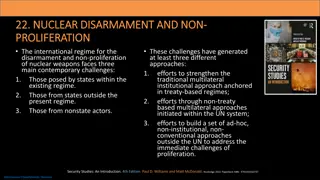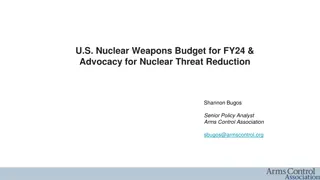Reactivity Margin in Nuclear Reactors
Reactivity margin is crucial in nuclear reactors to maintain criticality throughout the reactor core campaign. Loading a supercritical amount of fuel requires compensating absorbers to neutralize positive reactivity, ensuring safe operation. The total reactivity margin is the value of positive reactivity that can be released if all compensating absorbers are removed. This margin is essential for reactor stability and responsiveness to changes in reactivity during operation.
Download Presentation

Please find below an Image/Link to download the presentation.
The content on the website is provided AS IS for your information and personal use only. It may not be sold, licensed, or shared on other websites without obtaining consent from the author.If you encounter any issues during the download, it is possible that the publisher has removed the file from their server.
You are allowed to download the files provided on this website for personal or commercial use, subject to the condition that they are used lawfully. All files are the property of their respective owners.
The content on the website is provided AS IS for your information and personal use only. It may not be sold, licensed, or shared on other websites without obtaining consent from the author.
E N D
Presentation Transcript
Reactivity margin The nuclear power reactor is designed to operate at rated power for a fairly long time, called the reactor core campaign. This means: throughout the campaign the reactor must remain critical. Try to imagine how the first critical state of the reactor is created: the active zone of the reactor is gradually filled with fuel assemblies until a self-sustaining fission chain reaction begins in it. In this case, it is said that the first critical mass was collected in the core.
For prolonged operation of the reactor, it is necessary to load fuel into its active zone in excess of its critical amount. But you can not do it just like that, it's dangerous: once you load some supercritical amount of fuel into the core, the reactivity will be reported to the reactor. If the reactivity value increases to ee ~ 0.0064, the reactor becomes uncontrollable.
Therefore, the supercritical amount of fuel must be loaded into the reactor with simultaneous loading of compensating absorbers into the active zone. They serve toto compensate for the emerging positive reactivity when loading into the active zone of the fuel in excess of the critical amount. It does not matter what this compensating absorber will be, but the process of loading supercritical amounts of fuel into the core should always be accompanied by synchronous introduction into the active zone of the corresponding quantities of compensating absorbers.
Thus, charging the core with a supercritical amount of nuclear fuel results in a positive reactivity that is immediately suppressed by the compensating absorbers. The total reactivity margin of the reactor is that value of the positive reactivity, which is created due to the loading of the supercritical amount of nuclear fuel into the core and is simultaneously neutralized by the introduction of compensating absorbers into the active zone and is intended to provide the required reactor campaign.
In other words, the total reactivity margin - is the magnitude of the positive reactivity that could be released immediately with the mental (only mental!) removal from the active zone of all compensating absorbers. The total reactivity margin of the reactor is needed to maintain the reactor in a critical condition when it operates at a constant power level throughout the campaign and to compensate for reactor reactivity losses during its operation.
The amount of the total reactivity reserve should be such that it allows the operator (or automation system) to react quickly to any rapid changes in reactivity of the reactor and to compensate them in order to maintain the critical operating conditions of the reactor at a given power level. This part of the ORM can be compensated only by mobile absorbers. A part of the total reactivity reserve compensated by some mobile absorbers in the reactor is called the operational reactivity reserve
Operational this part of the general reserve of reactivity is named, firstly, because it is at the disposal of the operator of the reactor installation (the operator is engaged in the displacement of the absorber rods in the active zone), and secondly, because these removals of absorbers can be made rather quickly (= operatively), which ensures rapid compensation of changes in reactivity of the reactor in some transient processes.
The value of the total reactivity reserve throughout the whole reactor core campaign is decreasing, but at any point in the campaign it is composed of an operational reactivity reserve and reactivity reserves compensated by fixed (burn-out) absorbers and a liquid absorber (boric acid in water contained in the core of the reactor core ): (t) = orr(t) + ba(t) + la(t)
The values of both the total and operational reactivity margin during reactor operation vary due to changes in reactivity loss in the following physical processes: burnout of nuclear fuel - the process of a continuous loss of nuclear fuel due to its absorption by neutron nuclei; burnout leads to a decrease in reactivity; slagging of nuclear fuel - the process of accumulation in a working reactor of stable and long-lived fission products involved in the unproductive absorption of neutrons and, thereby, reducing the reactivity reserve;
Reproduction of nuclear fuel - the process of formation and accumulation in a working reactor of new types of fissionable nuclei immediately included in the general cycle of neutron multiplication and, thereby, increasing the overall reserve of reactivity; burnout of burnout absorbers is the process of slow destruction of immobile absorbers initially loaded into the active zone due to their absorption of thermal neutrons, leading to the formation of weakly absorbing products in their place, so that the reactivity reserve is released; poisoning of the reactor - the process of formation in the operating reactor of short-lived fission products involved in the unproductive capture of neutrons and, thereby, reducing the reactivity reserve upon their accumulation and increasing it upon their decay.
change in the concentration of boric acid in the water of the 1 circuit - from one name it can be understood that an increase in the concentration of boric acid leads to a decrease in the reactivity reserve, and a decrease, on the contrary, to its release; temperature changes in reactivity - with negative temperature coefficients of fuel and coolant reactivity, an increase in the temperatures of these elements leads to a decrease in the reactivity reserve, and a decrease in temperatures leads to a release of the reactivity reserve.
REDUCTION OF THE REACTIVITY MARGIN WITH THE FIRE OF NUCLEAR FUEL Burnout is the process of continuous loss in a working reactor of fissile nuclides due to their absorption of neutrons. Any fissile nuclide absorbs neutrons, and a part of the absorption ends with fissions, and the remainder - with unproductive radiation capture; but in any of these cases the fissile nuclides disappear. This process of fading nuclides in a working reactor is called the burnout of nuclear fuel.
The neutron absorption is inherent in all fissile nuclides at any level of neutron energy E. For example, for nucleus-235: a5(E) = 5f(E) + c5(E), therefore, fuel burnup is always due to neutrons of any energy present in the reactor spectrum. In particular, since our conversation mainly concerns thermal reactors of nuclear power plants, all the micro- and macro- sections of the reactions mentioned in the future will be cross- sections averaged over the spectrum of thermal neutrons and will be briefly indicated, without indicating neutron energy.
The burnup rate is nothing more than the rate of the absorption reaction by 235U nuclei of thermal neutrons. Therefore, the differential equation of the burnup rate has a very simple form: 5 5 dt dN = ( ) ( ) N t t 5 a The minus sign on the right side of the equation is evidence that it is a question of reducing the concentration of fuel nuclei with time t.
The main operating mode of the power reactor is the operating mode at a constant power level: Np (t) = idem. But the reactor power Np(t) at any time t is proportional to the product of the concentration of 235U N5(t) nuclei and the average neutron flux density in the reactor (t): Np(t) = ( E f5V ) N5(t) (t) = NN5(t) (t)
for a reactor operating at a constant power level, the differential burnup equation 235U taking into account the expression takes the form: p a idem C dt N dN = = = 5 5 5 N 5 a o o N It turns out that with a constant reactor power, the burnup rate of the main fuel in the reactor (235U) in time is constant. The solution of equation with the initial condition: t = 0 N5(0) = N50 is: 5 N t N C N = = = 5 a 5 a a ( ) 1 ( o ) N t N N t N t 5 5 5 5 5 o p o o o o
At any constant level of reactor power, the decrease in the amount of the main fuel in time follows a linear law. The rate of reduction in the amount of uranium-235 during the campaign is determined only by the magnitude of the reactor power level. N5(t) N5o Np1 Np2 Np1 Np3 Np2 0 t
Let's note one more circumstance: to maintain the reactor at a constant and really the same level of power throughout the campaign, it is required to increase the value of the average neutron flux density during the campaign according to a law inversely proportional to the value of the fuel core concentration that decreases with burnout: N t N 5 5 ) ( N 1 ( p p = = = o 5 ( ) 5 C N t ) 1 C N t t N o a o a o since N5(t) decreases linearly during the campaign.
Power production of the reactor The energy production of the reactor (W) is the total amount of energy produced the reactor at the given time from the beginning of the campaign of its active zone. If the reactor operates at a constant power level Npa certain time t, then it is clear that during this time it will generate W = Npt units of energy. The size of the reactor's energy output (and its increment) at nuclear power plants is measured in extra-volatile units MW h, MWdays, or GWdays (if it is a question of large energy works).
Loss of reactivity with fuel burnup. Taking into account the fact that the product value Np t = W (t), the form of the solution of the burnout equation becomes simpler and more general: That is, now the decrease in the concentration of fuel during the campaign of the active zone can be reflected on the graph not by a family of straight lines, but by one straight line: 5 a = ( ) ( ) N t N W t 5 5 o C N
The linear character of the decrease in the concentration of 235U with the energy production of the reactor. N5(W) 5 a N5o tg = N 0 W
Since the concentration of N5(t) is proportional to the thermal neutron utilization factor (t), which gives a proportional contribution to the value of the effective neutron multiplication factor in the reactor ke(t), which is practically proportional to the reactivity of the reactor , that the magnitude of the loss of reactivity due to burnout of fuel, practically monitors the amount of decreasing fuel concentration during the campaign. Therefore, the graph of the loss of reactivity due to fuel burn-up, depending on the reactor's energy output, is as unambiguous and linear as the schedule for the change in the 235U concentration itself. Thus, the main practical conclusion is that the loss of reactivity (reserve of reactivity) with burnup of fuel during the campaign is directly proportional to the value of the reactor's energy production.
Here the simplest case was considered, in which the regularity of the burnout process was illustrated by the example of the burnup of only one uranium-235. he linear nature of the burn-up, depending on the size of the reactor's energy production, is also characteristic of the real multicomponent fuel of an energy reactor in an arbitrary period of the campaign (i.e., 238U, 239Pu, 241Pu). 0 W (W) 0 23
Main characteristics of fuel burnup If the driver of the car goes on it on a long trip, then the first concern is the fullness of the fuel tank. Similarly, the energy reactor should be loaded with as much nuclear fuel as would be enough to provide the required campaign. However, in these two examples there is one fundamental difference: - the car stops when the tank is burned out "dry" (although, strictly speaking, in the car lexicon there is such a thing as "dead stock"); 24
- the reactor stops working when not all the fuel is consumed in it, but the entire reactivity reserve is exhausted, that is, the reactor shutdown moment - the last moment when it still remains critical, which means that it still contains one critical mass of fuel. Thus, it turns out that all nuclear fuel for one campaign in the reactor "burn out" is impossible. 25
Nuclear fuel is expensive. The extraction of uranium ore, the production of natural metallic uranium, its enrichment with the 235U isotope, the manufacture of a fuel composition, its sintering into tablets and their finishing, the production of fuel elements and fuel assemblies - are all very complex technological processes that require large material and energy costs. 26
It is clear that throwing out a fairly large amount of unburned nuclear fuel in a cemetery of radioactive waste would be a very stupid thing. The spent fuel is sent for regeneration, where the fuel components are separated from the accumulated fission products over the chain of complex process operations, re-enriched with the 235U isotope and re-included in the fuel cycle. It should be noted that the regeneration of nuclear fuel is no less complex and expensive than the production of "fresh" fuel. 27
That is why it is very important that in the process of the campaign burn as much of the fuel as possible, and for regeneration, the smallest part of it should remain. The following characteristic is the measure of the fuel efficiency in power reactors: the burnup depth o Considering that the thermal energy of one act of fission of 235U is ~200 MeV and that 1 eV / atom This corresponds to 23 kcal / mol (1 kcal = 4186.8 J / mol), it can be considered that when 1 g 235U is released energy: = 0.95 MWd/g 28
burnup depth of fuel is the fraction (or percentage) of the burned main fuel (235U) from its initial quantity. It can be defined in different ways: a) The burnup depth - is denoted by the letter B (or z) and, in accordance with the definition, is equal to: ( ) ( ) N N t N t = = = 5 5 5 5 o ( ) 1 z t t a o N N 5 5 o o 29
By elementary substitutions, it is easy to show that the burnup depth at any moment of the campaign t is a quantity directly proportional to the energy production value W(t), if one does not take into account that part of the generated energy that is obtained as a result of fission of plutonium nuclei. You can write: ) ( 5 5 t W N C N o N o 5 a N N t = o ( ), 5 a 5 5 = ( ) ( ). z t W t C N 5 N o 30
The efficiency of the use of the main fuel in the reactor during the time of the core campaign can be judged from the figures of the maximum burn-out (that is, the burn-out at the end of the campaign). For reactors of the VVER-1000 type, Zmax= 0.30 - 0.35. 31
b) The burnup - depth is the energy production at the moment of the campaign, per unit mass of originally loaded uranium. Here we are talking about all uranium (235U + 238U), which is loaded into the active zone before the campaign begins. If we denote the depth of burn-up through b, then, in accordance with definition W t b ) ( = ( ) t M Uo 32
The spent nuclear fuel discharged from reactors is transferred for processing only after a certain exposure. This is due to the fact that among the fission products there is a large number of short-lived radionuclides, which determine a large fraction of the activity of the fuel discharged from the reactor. Therefore, freshly loaded fuel before processing is kept in special stores for a time sufficient for the decay of the main quantity of short-lived radionuclides. 33
This greatly facilitates the organization of biological protection, reduces the radiation impact on chemical reagents and solvents in the processing of processed nuclear fuel and reduces the set of elements from which the main products must be purified. So, after two or three years of exposure, the activity of irradiated fuel is determined by long- lived fission products: Zr, Nb, Sr, Ce and other REE, Ru and -active transuranium elements. 96% of spent nuclear fuel is uranium-235 and uranium-238, about 1% - plutonium, 2-3% - radioactive fission fragments. 34
Characteristics fuel of Heavy- water SGHWR Gas Cooling- given HTGR UO2, ThO2 Fast reactors PWR Type of fuel UO2 UO2 UO2, (U,PuO)2 Source fuel % 235U 1.5 - 5 1.8-2.2 <93 20-30% Pu)2 Spent Fuel,% 235U 0.7-1.3 0.8 50 --- Depth burnout, GWd / t 40-50 ~20 100-130 60-120 35
Nuclear fuel burn-up Nuclear fuel - material containing fissile and usually reproducing (raw) nuclides and ensuring the flow of fission chain reaction in a nuclear reactor. Nuclear fuel burn-up - the process of converting nuclei of a fissile nuclide into nuclei of other non-fissile nuclides due to fission and radiative capture of neutrons. 36
Decrease of the concentration of 235U nuclei in time N5(t) in the averaging of burn-up process by the volume of the core is described by a burn-up differential equation: dN5(t) / dt = - a5 N5(t) average(t) 37
dN5(t) / dt = - a5 N5(t) average(t) where: a5= = f5 + 5 average(t) cross section of235U; average thermal neutron flux density by the volume at time t; average concentration of235U nuclei by the volume of the core, i.e. the number of235U nuclei per unit volume of the core at the moment of time t. N5(t) 38
If averagedoesn't depend on time ( average=const ), the solution is: N5(t) = N5(0) * exp( a5 average t) where: N5(0) concentration of 235U at t=0 From this it follows that when working with constant neutron flux density, the concentration of the fissile nuclide decreases exponentially. The greater average value, the faster it decreases. 39
It is easy to show that exponential decrease of the fissile nuclide concentration (for example, 235U) average=const, will entail exponential decrease of the reactor power. 40
Based on the fact that fission of 235U releases f~200MeV=0.32 10-10J of energy, and the number of fission events occurring per 1 s in the volume Vuof the fuel loaded into the core is equal to Vu f5 N5 average 41
reactor power W, (without fission energy losses to the environment), can be defined by the product: W = 0.32 10-10Vu f5N5 average For each particular reactor product 0.32 10-10 Vu f5 during operation does not change. 42
Units of fuel burnup depth (B) One of the most important indicators of a nuclear reactor fuel economy is burn-up fraction. Currently, there are several ways to determine the fuel burnup fraction in the reactor core: 43
1) as the ratio of energy production Q = W t (MW day), (GW day) obtained per time t (days) of reactor operation by power W (MW) to the total initial loading m (t) of uranium: (MW day/ U); 1= Q / m = Wt / m 44
2) as the ratio of mass of the burn-up fissile nuclide mburnt(kg) to the weight of the originally charged fissile nuclide mU(kg): 2 = (mburn-up / mU ) 100% 2 = (mburn-up 235 / mU235 ) 100% 45
3) as the ratio of the mass of burn-up fissile nuclide mburn-up (kg) to a full initial loading m ( ) of uranium: 3= mburn-up 235/ m (kg/ U); 46
In modern VVER with enrichment 3 5% at 2 3 year campaign with partial overloads reaches 40 000-50 000 MW day/ kg 40-50 MW day/ t and in the most intense fuel elements it is even more. Maximum burn-up fraction is determined by the technological stability of fuel elements depending on fuel enrichment, type of coolant, material of FE cladding and structure. (depth burn) or 47
Reactor slagging Nuclear reactor slagging means a process of accumulating stable and long-lived nuclides in fuel involved in nonproductive neutron capture. In reactor operation, their concentration increases monotonically and doesn't decrease after shutdown. 48
Among fission products of 235U by thermal neutrons there are more than 250 different nuclei, about a quarter of which are slags. The loss of reactivity by slagging is defined as follows: sl= -gsl = ( i/ a5) 49
sl= -gsl = ( i/ a5) where:gsl quantitative measure of slagging; nonsl utilization factor of thermal neutrons in non-slagging fuel; Microscopic radiative capture cross-section of thermal neutrons by i slag; number of slags forming in fuel. i n 50
